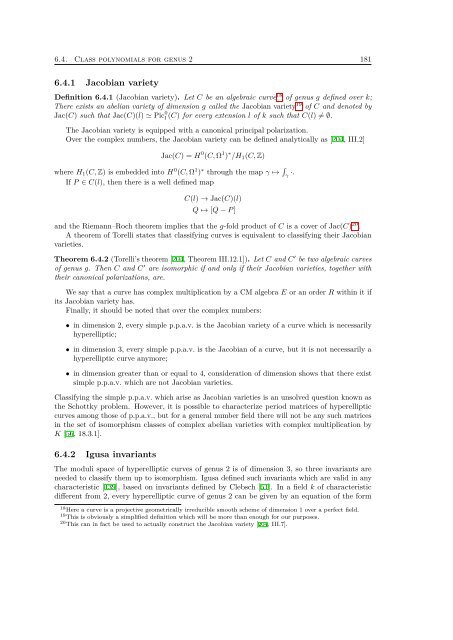here - Sites personnels de TELECOM ParisTech - Télécom ParisTech
here - Sites personnels de TELECOM ParisTech - Télécom ParisTech
here - Sites personnels de TELECOM ParisTech - Télécom ParisTech
Create successful ePaper yourself
Turn your PDF publications into a flip-book with our unique Google optimized e-Paper software.
6.4. Class polynomials for genus 2 1816.4.1 Jacobian varietyDefinition 6.4.1 (Jacobian variety). Let C be an algebraic curve 18 of genus g <strong>de</strong>fined over k;T<strong>here</strong> exists an abelian variety of dimension g called the Jacobian variety 19 of C and <strong>de</strong>noted byJac(C) such that Jac(C)(l) ≃ Pic 0 l (C) for every extension l of k such that C(l) ≠ ∅.The Jacobian variety is equipped with a canonical principal polarization.Over the complex numbers, the Jacobian variety can be <strong>de</strong>fined analytically as [204, III.2]Jac(C) = H 0 (C, Ω 1 ) ∗ /H 1 (C, Z)w<strong>here</strong> H 1 (C, Z) is embed<strong>de</strong>d into H 0 (C, Ω 1 ) ∗ through the map γ ↦→ ∫ γ ·.If P ∈ C(l), then t<strong>here</strong> is a well <strong>de</strong>fined mapC(l) → Jac(C)(l)Q ↦→ [Q − P ]and the Riemann–Roch theorem implies that the g-fold product of C is a cover of Jac(C) 20 .A theorem of Torelli states that classifying curves is equivalent to classifying their Jacobianvarieties.Theorem 6.4.2 (Torelli’s theorem [204, Theorem III.12.1]). Let C and C ′ be two algebraic curvesof genus g. Then C and C ′ are isomorphic if and only if their Jacobian varieties, together withtheir canonical polarizations, are.We say that a curve has complex multiplication by a CM algebra E or an or<strong>de</strong>r R within it ifits Jacobian variety has.Finally, it should be noted that over the complex numbers:• in dimension 2, every simple p.p.a.v. is the Jacobian variety of a curve which is necessarilyhyperelliptic;• in dimension 3, every simple p.p.a.v. is the Jacobian of a curve, but it is not necessarily ahyperelliptic curve anymore;• in dimension greater than or equal to 4, consi<strong>de</strong>ration of dimension shows that t<strong>here</strong> existsimple p.p.a.v. which are not Jacobian varieties.Classifying the simple p.p.a.v. which arise as Jacobian varieties is an unsolved question known asthe Schottky problem. However, it is possible to characterize period matrices of hyperellipticcurves among those of p.p.a.v., but for a general number field t<strong>here</strong> will not be any such matricesin the set of isomorphism classes of complex abelian varieties with complex multiplication byK [56, 18.3.1].6.4.2 Igusa invariantsThe moduli space of hyperelliptic curves of genus 2 is of dimension 3, so three invariants arenee<strong>de</strong>d to classify them up to isomorphism. Igusa <strong>de</strong>fined such invariants which are valid in anycharacteristic [139], based on invariants <strong>de</strong>fined by Clebsch [51]. In a field k of characteristicdifferent from 2, every hyperelliptic curve of genus 2 can be given by an equation of the form18 Here a curve is a projective geometrically irreducible smooth scheme of dimension 1 over a perfect field.19 This is obviously a simplified <strong>de</strong>finition which will be more than enough for our purposes.20 This can in fact be used to actually construct the Jacobian variety [204, III.7].
















